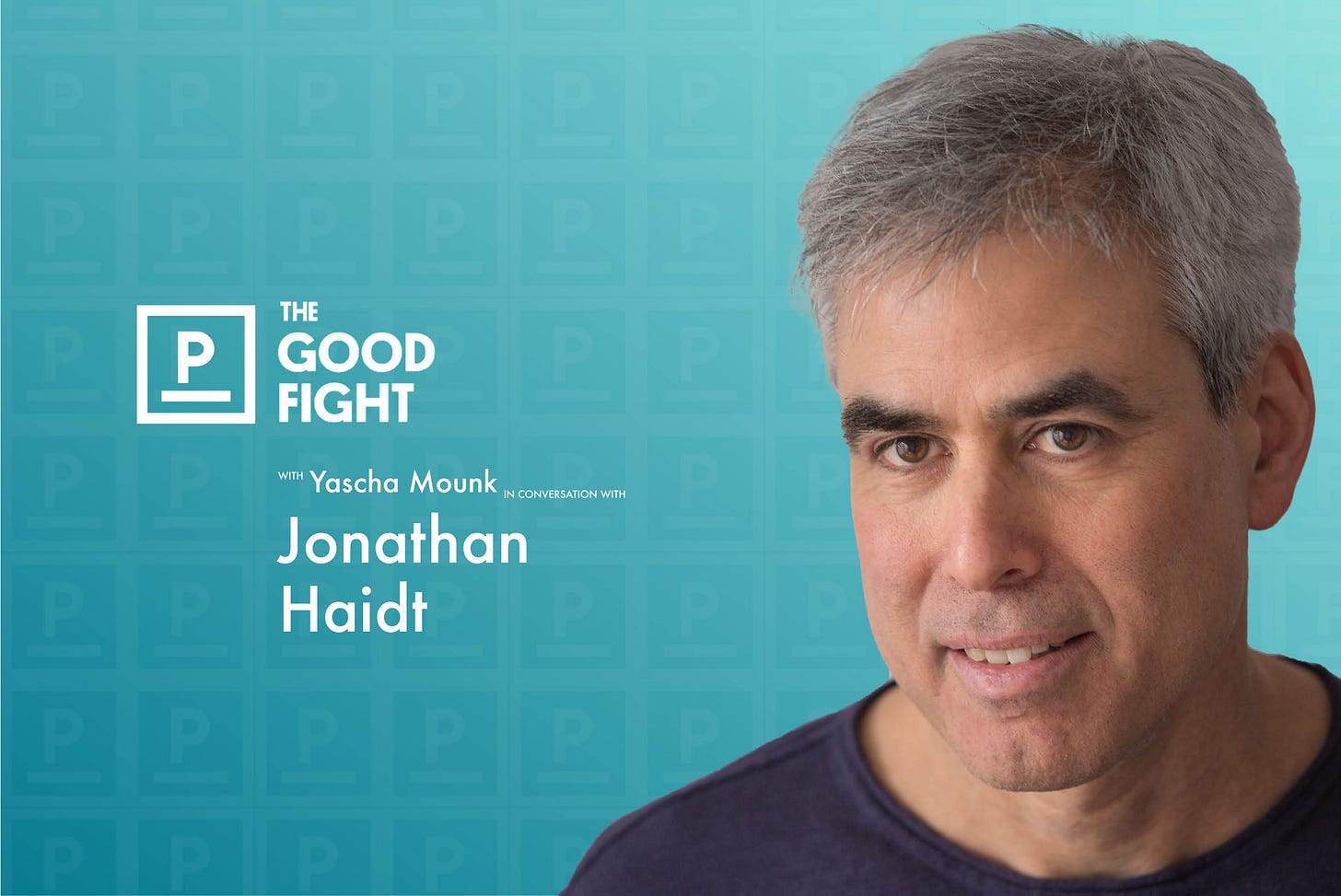Jonathan Haidt is a social psychologist and the Thomas Cooley Professor of Ethical Leadership at NYU's Stern School of Business. He is also a member of Persuasion's Board of Advisors. Haidt is the author of The Righteous Mind and, with Greg Lukianoff, co-author of The Coddling of the American Mind. His new book is The Anxious Generation: How the Great Rewiring of Childhood Is Causing an Epidemic of Mental Illness.
In this week’s conversation, Yascha Mounk and Jonathan Haidt discuss the significant rise in mental illness among teenagers, particularly young girls; why social media has a negative impact on childhood development; and how we can mitigate the damage by cultivating phone-free norms and more childhood independence.
The transcript and conversation have been condensed and lightly edited for clarity.
Yascha Mounk: It's always a pleasure to have you on the podcast and particularly when you have an important new book which you have just published called The Anxious Generation, which really speaks to so many core concerns of what is happening in the United States, in Britain and around the world today.
Why should we take this trend seriously? Why should we think that there really is something unusual about the rise of mental illness and other ills among teenagers and particularly young girls? And why should we think that this really is down to the rise of the internet and of social media in particular? And now I'm asking this because of course there have been many moral panics over the course of decades, right? Why is this not a moral panic, but a real trend that’s going on?
Jonathan Haidt: There certainly is a moral panic going on and it looks similar to previous ones. You know, the press gets involved, you get scare stories. But the question is, is it a justified panic or not? And with previous ones, like comic books, novels back in the 18th century—with previous ones there wasn't clear data showing gigantic increases in mental health or suicide. Now there is. I'll just trace it out for you.
The mental health of teens gets especially bad for Gen X: In the ‘80s and ‘90s Gen X has very high suicide rates. The millennials actually have slightly better mental health than Gen X. Jean Twenge was really the first to graph out these large data sets and to show that all of a sudden around 2012, there's a hockey stick, and all the numbers begin to go up. We're talking about rates of depression, anxiety, self-harm and suicide. Suicide begins a couple years earlier, but the other three are all right around 2012, plus or minus a year. Jean Twenge was the first to raise the alarm in her Atlantic article “Have Smartphones Destroyed a Generation?” And a lot of psychologists attacked her for that and said, “You're cherry picking. This is just another moral panic. It's not even real. Young people are just very comfortable talking about it. This is just self-report.” So that was a very reasonable view in 2017. It was a big debate. And then by 2018-2019 when I entered it because of having written The Coddling of the American Mind with Greg Lukianoff, and we said one of the contributors to the craziness on campus is that we had an influx of students in 2014, when Gen Z arrives, who are just set much more towards being anxious, towards seeing threats. Books, speakers—these could be dangerous. It wasn't like that in 2012, but by 2015 we had an influx of students who were just much more anxious and we were seeing this all over the country and people writing about this. So that's what got me into it was what happened on university campuses.
So in 2017 to 2019, Coddling comes out. I get in debate with some of these psychologists. We can call them the skeptics, who think there's nothing happening. And if there is something happening, it's not caused by the phones. But you see sort of this hockey stick shape, the lines go up and up and up from 2012. They go up a little faster in 2020 and ‘21 because COVID did make things worse. But COVID was really just a blip—the rise was almost all in place before then, and it's continuing to the present day. So we have a mental health catastrophe.
People questioned it in 2017 but the numbers have kept going up and nobody doubts now that there is a mental health crisis; rates of almost everything related to anxiety, depression and self-harm are up between 50 and 200 percent depending on the sub-population. We know there's a mental health crisis.
Mounk: You alluded to the fact that one of the skeptical arguments is that this might be self-reported, right? That people are overdiagnosed with having anxiety, ADHD or other kinds of conditions, and perhaps overmedicalized.
I found your data that you present in the book very convincing that the increase has not just been in the kind of categories where changes in medical practices may feasibly have made a difference, but also in objective measures, in suicide rates, emergency room visits for self-harm that, even before COVID, had gone up by 188% for girls and 48% for boys (we'll come back to that question of boys versus girls later).
Having read the book, I’m fully convinced that there is a mental health emergency going on and that you can't explain it away by saying this is a change in medical practices. But why tie it to social media particularly? What is the evidence that it has to do with phones rather than with the 2008 financial crisis or the polarization of our politics or worries about climate change or any of the other kinds of things that people like to adduce as competing explanations?
Haidt: That's right. When we see something, we think in stories—I think it's called the “pundit bias.” Whatever happens, it's because of the pet theory that you were concerned about over the last 10 years. And so that certainly happens. People have their favorite theories. What convinced me that it's real and related to phones and social media—the key thing was when we discovered what was happening at the same time in the other English-speaking countries. This is work done by Zach Rausch, my lead researcher. I said, “Zach, I already have a lot of evidence from the UK.” We reported that in Coddling. Go look at all the other countries. Collect every bit of evidence you can. Draw all the graphs. Find out, is this international?
And it turns out it is. It's going exactly the same way at the same time in all five of the main Anglosphere countries. Zach also found out that it's happening in Scandinavia. Now this is actually really interesting. It's not happening in Eastern Europe. By “it,” I mean the rising rates. It seems to be happening, basically, in the Protestant countries, in the countries that give maximum freedom to kids, which we'll come back to.
It's not happening in countries that are getting more religious, like Eastern Europe. And in Southern Europe, it's happening a little bit but not as much. So the point is, once you see that girls started cutting themselves and overdosing on their pills around 2012-2013 in the US, UK, Canada, Australia, New Zealand, suddenly these other explanations like school shootings and Donald Trump—the only one that fits the timing would be the school shootings because of the Newtown massacre in 2012—but that wouldn't explain why girls in New Zealand began checking into hospitals for self-harm.
So the only possible things that could explain the international figures are the global financial crisis, but that makes no sense because that was 2008. And by 2011, the economies are improving, stock markets going up, unemployment's going down. So there was no sign of any problem for the first three or four years of the crisis. And after the crisis is over and everything's getting better, ever since then things are getting worse and worse and worse continuously for 10 years.
Mounk: It would be puzzling why somebody who is 15 or 16 today would have mental health that's really compromised by the 2008 financial crisis, right?
Haidt: And why would the fallout of the global financial crisis especially hit preteen girls? They're the group that gets hit the hardest. Their lives are transformed. They're the ones whose rates of, especially self-harm and suicide, are up by a lot more than 100%. So that doesn't make any sense. The global warming fears—you might say, well, Greta Thunberg really made it a global issue, but that was like 2017-2018, so that doesn't explain it either. Also, there have been all kinds of threats in every generation: When I was young, it was nuclear war, it was environmental threats. There've been previous waves of concern. And what effect do such threats have on young people? It used to energize them.
If you are concerned about something and you become an activist, you have a greater sense of meaning, a greater sense of connection. And that was true until the smartphone era. Once kids move on to smartphones, all of a sudden, activists and political activists are now less engaged. They have less sense of meaning in their lives. It just doesn't work to point to any other explanation.
Mounk: So you're saying that there are three kinds of correlational studies that have been made, that look at the timing of when social media is introduced and then more experimental studies. What do these show?
Haidt: The correlation studies are very clear. Jean Twenge and I—let's call us the alarm ringers because we're ringing an alarm. And then there's the skeptics on the other side and of course they think that we're moral alarmists or panickers or something. But you know, if an alarm needs to be rung, then you want to have alarm ringers.
The amazing thing is we actually all agree on the size of the correlation. They'll often cite numbers that show that it's close to zero for all digital media including television: That is, the number of hours that a kid spends on all digital media including television is often not correlated with their mental health. But whenever you zoom in on girls and social media, you always find a correlation. And we actually all agree that the correlation is around .15. They say it's .1 to .15, but that's mixing boys and girls. Whenever you separate out girls, there's always a higher correlation than it is for boys. We all agree it’s about .15, which might sound small to people who took a stats class. But in the social sciences, in public health, you almost never get correlations of .3 or .4. It's all small effects. That doesn't mean it's a small effect in the world. We also all agree that heavy users are two or three times more likely to suffer from depression. What parent would let their daughter spend three hours a day on something that was known to double or triple her rate of depression? That's the correlation studies. But of course correlation doesn't cause causation and that's what the debate has been about for ten years now.
But here's the cool thing. Whenever you dig in, you always find that the story gets sharper. Some longitudinal studies use a period of a day. We look at one day and the next day, but this ignores the fact that social media is addictive. If you have a heroin addict and you say, we're going to take away your heroin for one day, let's see how you're doing tomorrow—not well. If you are away for a month or more, then you're doing better. And that's what we find. So with the longitudinal studies, those that used a week or shorter generally don't find an effect.
By far the most important is the experimental studies. That's what we do in the social sciences: If you want to establish causality, you do an experiment. And so Zach and I have collected about 30 or 35 experiments in our Google Docs. And you find the great majority of experiments find a significant causal effect. It takes a little longer for your brain to reset, dopamine neurons to reset. But those that use a month or longer almost always do find an effect. So I'm like, what more can we do? We have a global mental health crisis. It's not all countries, but it's in many, many countries.
There is no other theory on the table. There's only this theory. It's the only one that can explain the timing of it. We have the correlation of evidence, we have the longitude of evidence, and we have the experiments. What more can I do to persuade you that this is what's happening? Oh, I have an idea. Let's ask the kids. Let's ask the teenagers. What do you think it is? And what do you think they say? Do they say it's school shootings or global warming? No, they say it's the phones. You know, they might enjoy their particular phone because they're in a trap. We'll get to that. But the teenagers themselves think that the phones are messing them up. And this is the most amazing thing to me.
When you look at what Gen Z is writing about this, they're all telling the same story of devastation. If this was a murder case, you have a body, you have a guy holding the gun, you have eyewitnesses, you have ballistics tests—at some point you have to think maybe this guy did it.
Mounk: And I certainly am somebody who came to this argument with a certain healthy dose of skepticism just because I saw the similarity to other moral panics in the past, but have been, I think, convinced by the evidence you marshal in the new book that very clearly there's a mental health emergency going on and that it’s very, very likely, this is in fact caused by social media.
I want to move us to some of the deeper story you tell, which goes beyond the sort of headline finding, but there is this crisis that it is to do with social media, to give an account of, what a healthy childhood would look like and how it is that social media is undermining that kind of healthy childhood. So why is it, to put the question in a slightly counterintuitive way, that you are concerned for example about data showing that children are less likely to injure themselves than they were in the past? What is it about certain forms of risk-taking and other things that actually were part of a healthy childhood, and why should we be worried about that?
Haidt: I wrote the first chapter of the book originally thinking it was going to be chapter one of my big book on democracy, and so I wrote chapter one thinking, let me look at what happened when teens put their social life on social media. But the graphs were so shocking, and once it was clear it was international, I couldn’t just show these graphs and then move on.
It's not just social media. It's what I call the phone-based childhood that blocks many developmental pathways. The purpose of childhood is to give the animal time to wire up its brain and learn behaviors that we'll need in adulthood. And what is it that children need to do to wire up? Play. All mammals play, and play is essential. If you deprive baby rhesus monkeys, mice or any animal of play, they don't develop proper social skills. They're much more anxious for the rest of their lives. They don't explore as much. So we need play, but it needs to be independent where you make the choices and you make mistakes and then you suffer the consequences which are generally very low in play. But that's how you learn. It's this repeated cycle. And the magic ingredient turns out to be the sense of thrill, which is fear. And then if you overcome it, you're just so excited. You're jumping up and down. And we can all remember these moments from our childhood. And so thrill is really important. And there's a Norwegian play researcher, and also Peter Gray, a great play researcher at Boston College—children need to seek out risk and thrill repeatedly. If you take those away, you don't get as much growth or overcoming of anxiety. And so kids used to take risks. When I was a kid in elementary school, we would make bike ramps, we'd ride our bicycles, try to get a little hang time, and you would sometimes fall and hurt yourself. Why are kids doing that? Why are kids choosing to do things where it's pretty certain they're gonna get hurt? They need to do that to wire up. And so the amazing thing as we watch is in the ‘90s, especially we became really over-protective, smaller families invest more in each, more concerned about getting into college, more fears of strangers. So childhood changes before the smartphone era and we take away a lot of risk. We don't want our kids taking any risks. And so the findings you're alluding to, these are I think some of the most surprising findings in the book: The CDC tracks hospital admissions for unintentional injuries. You fell off a ladder, you fell on a bike. The people that get injured the most, traditionally, are teenage boys. They have very high rates of injury, and then as men get older, the rates go down. That's the way it used to be.
But what happens beginning in the early 2000s is the boys’ rate begins going down and down, especially after they move on to smartphones around 2012. Boys are no longer going to hospitals for broken arms. It's a very rare thing now. Now you might think that's good, but boys are now getting injured at the same rate as 50-year-old men, teenage boys who you think are out taking risks, same hospitalization rates as 50-year-old men, and lower hospitalization rates than teenage girls had 15 years ago. Because boys are not doing anything where they could get hurt. They come home after school, they put on their headphones, they play video games with their friends. Now it's great fun, but it's missing most, it's missing many of the active ingredients of play. It's missing actual fear, actual thrill. And so I don't think that, I don't think our kids are getting the risk exposure that they need to be able to manage risks for the rest of their lives. By the time they come to us in college, they seem to think that reading Shakespeare could be dangerous for them.
All else equal, I would rather there were fewer broken arms. But if the cost of having fewer broken arms is a doubling of the suicide rate, I think from almost all of recorded history, at least as far back as I can see data, young people were much more likely to be killed by someone else than by themselves. But beginning in this period, I think it's around 2012, the suicide rate for the first time exceeds the murder rate. So kids are still getting hurt and killed, but it's by themselves now. And I think that's really, really sad. So that's one thing. And even aside from the overall death statistics, if you were to ask people who suffer from mental illness, would you rather have depression for life, which you're gonna battle for life, would you rather have a broken arm in which you're gonna have to be in traction for three months? I think everybody would pick the broken arm.
The loss of human happiness, flourishing, and productivity from mental health is staggering. We've known that for a long time. So what's going to happen as this anxious generation—I don't know how much they get over it. We don't know yet. But presumably, if their minds are set more towards defend mode than discover mode, they do seem to be more anxious in their 20s as well. So I'm not saying, you know, it's locked in, you can't change. But I think we’re going to see this generation more anxious and depressed for the rest of their lives, on average. Most people are doing okay, but on average the numbers are much higher than they ever were.
Mounk: I want to come to solutions later in the conversation, but this is something where parents might be able to make some transition on their own, right? They might be able to entrust their child with running an errand earlier than other parents or earlier than the neighbors. They are able to say, hey kids, go and play in the front yard without supervision, even if other parents aren't doing that.
How do you empower parents to do that? Because quite understandably, parents will also feel that you’re pretty convincing. But they might think “My god, if something happens to my child because I wasn't supervising them, I couldn't live with that. What if the neighbors call the cops and say that I'm a bad parent for not looking after my kids?” So how can you persuade parents that this is the trade-off we're facing? How can parents have confidence that incurring those extra immediate physical risks in fact helps to make their kids more resilient?
Haidt: What I'd say to parents is that you're not alone. And if you try to solve this by yourself, you run into these collective action problems. If you're the only one sending your kid out, your kid has no one to play with. That's why I co-founded Let Grow with Lenore Skenazy, Peter Gray and Daniel Schuchman. Lenore has been writing about this as a national crisis, the loss of play in children and how we need to trust our kids. We need to give them these experiences. I would urge anyone with kids in elementary or middle school or younger, please go to Letgrow.org. We have all kinds of ideas.
For one thing, we've gotten laws changed in seven states now, eight states, to say that if you give your kid some independence, that cannot be taken as evidence of neglect. So if you let your kid walk to the store and some nosy neighbor calls the cops, eight states now say that is not neglect. we're changing laws and we're offering programs, including some baby steps, for getting this done. So parents are going to be reluctant to do it unless lots of other parents are doing it. And so our most powerful intervention, it's so simple and it's so powerful: It's called the “Let Grow Experience” and it's a homework assignment. The assignment is go home, find something that you can do at home that you've never done before (maybe it's walk the dog, maybe it's walk go to the store and buy fruit). Come up with something that you think you can do that you've never done before. Work it out with your parents and then do it. And what's so brilliant about this is parents who would never let their kid walk to the store, three blocks away in a safe suburban neighborhood—well, it's a homework assignment. And the other kids are doing it too. So now it feels normal when you have a whole elementary school with kids going to the store to buy milk and playing on their own and walking their dogs. We're stuck in a set of collective action problems. They're hard to escape as individuals, but if we do it together, we can escape.
The antiphobic effects are extraordinary. That is, kids who are so afraid to walk to the store, they do it the first time, they're a little afraid. They come back and they're jumping up and down. They're so excited. And then they want to do it again. And after two or three days, they're perfectly comfortable walking to the store and then they can walk to school. And guess what? This is so much more effective than Prozac. So we think that if the Let Grow experience were done in middle schools around the country, we think this would really bring those graphs down of anxiety and depression.
Mounk: Ironically enough, I'm recording this in Berlin, and I'm looking out of a window into a residential neighborhood that is very much in the center of Berlin. And I just saw two 10-year-olds walk down the street. One of them had a soccer ball. And of course, this was perfectly normal when I was growing up in Germany, and it continues to be much more normal in Germany than it is in the United States. So those local norms can certainly differ very, very strongly in different places.
I like this story you tell that, in a way, the onset of the problem was a decline in the play-based childhood, which predated and then perhaps ran parallel to the introduction of what you call the phone-based childhood. And that part of the reason why the phone-based childhood could have such a damaging impact is that a lot of the most healthy forms of practices that predated it had already started to recede. How is it that the phone-based childhood comes in to fill up this vacuum, and what is it specifically about the internet, the time we spend with digital technology, and specifically social media that then helps to create the mental health crisis you're concerned about?
Haidt: So the decline in play, the decline even in time with friends, that begins in the ‘90s and into the 2000s. Yet the mental health stats are not getting worse. They're actually getting a little bit better for millennials compared to Gen X. So I think the loss of play is weakening kids, but it's not making them depressed and anxious just yet. Then a number of things happen in rapid succession. So, in 2007, the iPhone is released, but kids don't have it. It's expensive. In 2008, we get the software development kits and the App Store. So the iPhone, which had been just this amazing digital Swiss army knife that you could use to achieve your ends becomes a platform by which companies bid to get the attention of users with push notifications. So the iPhone in 2007 was not at all toxic, but by 2010, you have an environment in which if you have a phone, there's an infinite number of things to do and there are companies pinging you, notifying you, trying to get you to stop what you're doing and come over there. In 2010-2011, I think only about 20% of American teens had a smartphone. They're still on flip phones. In 2010, there's no sign of a problem. Even in 2011, there's no sign of a problem. By 2015, 75% of teens have a smartphone. What also happens in this period is high-speed internet. In 2007, most families did not have high-speed internet. You had to pay for each text, so you're not going to be on it all day long.
But by 2015, almost everyone has high speed internet. Also, Instagram comes out in 2010. 2012 is the year that Facebook buys it. You get the first front-facing camera in 2010, iPhone 4. So what I'm trying to get at is that a lot of stuff happens between 2010 and 2015. The tech environment was not particularly toxic for the millennials. They were on flip phones. They went through puberty on flip phones, which meant they would text each other and say, let's meet up. I'll see you at the mall.
Mounk: And one of the differences is that at that point you communicate with people who you know online and it's a specific kind of one-to-one or sometimes one-to-several communication, right? it's a tool to meet up, to let a friend know about something one-to-one. And I take it that what really makes social media different other than the more ubiquitous presence in people's lives and so on is that it's a different form of self-curating, right?
Once you are posting something on Instagram with a front-facing camera, which is to say that it's probably going to be a selfie, you're really curating your image to the world, which is a different kind of activity.
Haidt: Exactly. So it's revealing that until around 2012 we called these things social networking systems. Facebook, Friendster, Myspace, these were all called social networking systems. They were ways to connect people. Of course it's good to connect people by phone and the smartphone, the flip phone did that. It was just a communication device so it's no problem for the millennials.
But then, and I have an essay in the Atlantic with Tobias Rose-Stockwell on this, in 2009 is when you get the retweet button, the like button. So social media itself changes a lot around this time, 2009-11. After that, we call them social media platforms. And think about how you would want your child to grow up: Would you want your child to grow up with a device that lets her talk to or text her close friends and you? Sure. Or would you rather your child grow up on a social media platform performing for hours a day, and watching the performances of others, including a lot of strangers. And I mean a lot of strangers—the most recent Gallup data is five hours a day, average social media time for American kids. Five hours a day. The biggest chunk of that is TikTok videos and YouTube videos. Five hours a day performing and consuming performances. It's not connecting. And so this is what I'm trying to say: That between 2010, when things were still normal and kids were healthy, to 2015, when they were not normal and not healthy, is the great rewiring of childhood. However American childhood was evolving, it wasn't particularly toxic. And then in five years, we transformed it into a form in which it's just very hard to grow up with a normal childhood, a normal brain, normal social skills, normal emotions. It's very hard. Kids who are playing team sports, who are anchored in the real world, are doing better. But kids who don't have team sports, they don't have religion, they don't have things to anchor them, those are the kids that got washed away.
Mounk: We've seen increases in things like mental illness among boys and girls but you also emphasize throughout this conversation and throughout your work that girls were more harmed by this than boys. What is it about the different behaviors of girls and the different kinds of experiences they have online which makes them so much more vulnerable to the impact of platforms like Instagram or TikTok?
Haidt: If we focus on social media, then I can say with confidence that girls are more harmed by it. But if we look at the great rewiring of childhood, then it's gonna be a more complicated story, which we'll get to in a moment. So girls are more harmed by social media because if you look at their insecurities and their desires, social media is really designed for them. Girls are more focused than boys on human relationships. Girls are more attuned to the world of social relationships. Boys are more literally on the spectrum. This is Simon Baron-Cohen's work. It's literally the case that testosterone changes the female brain pattern over to a male brain pattern, which is higher systemizing, lower empathizing. So boys are more into mechanical devices, mechanical systems, memorizing maps. So there are psychological differences between boys and girls related to prenatal testosterone. And social media is like supercharging the social side of life.
But it's drowning you in stuff about other people. And so everybody focuses on the content, like, “Oh, if we could just clean up the content, it would be okay!” No, it's not the content. This is what Marshall McLuhan and Neil Postman were trying to say: The medium is the message. And so if you're a girl, you're growing up on a stage. Daily life is people commenting on your looks, your hair, your stomach, your breasts. Strange men are adding to the comments (because you need them as followers, because you need a high follower count). Girls are really easily swayed to believe that the most important thing is their appearance and their sexiness. And that's terrible.
Boys are much more anxious than they used to be. They're much more risk-averse. But for boys, I think what we're gonna see is that their suffering is just beginning. That is, boys, because they are not as well educated now, they're not getting good jobs as much, they're not as ambitious. Yeah, they might have had fun playing video games. And they do say that. I mean, the games are amazingly fun. But it's sort of like the ant and the grasshopper. While the girls are working away, really anxious about getting into college, the boys are having fun. Well guess what? The oldest members of Gen Z are 28. In a few years the girls are going to have jobs and some money. The boys are still going to be living on their parents' sofas. So I think the boys' suffering is really just beginning and it's going to be a pervasive sense of being a loser for the rest of their lives. This is really ruining boys' development every bit as much as it's ruining girls' development.
Mounk: What do we do about all of this? We started to have a conversation a little bit in the context of how to go back to a play-based childhood and the challenges are real there. How can we reintroduce a play-based childhood as individuals and as communities? And how do we get away from the phone-based childhood? What can we realistically do? What can listeners to this conversation who you've persuaded actually do in their lives to make a difference?
Haidt: The amazing thing to me, as I've been on this project since 2019, is that while there are a few psychologists that disagree with me, I have a healthy normal scientific debate with a few psychologists, I faced no other opposition. These concerns are shared by everyone: teachers, parents. They're bipartisan, and we're seeing that in Congress. So everything's lined up for us to make a change. The only real opposition I get is from an intense feeling of resignation and despair. People feel this is just too big. The train's left the station, the horse has left the stable. There's a pervasive sense that we can't do anything. We just have to adapt to it. I think that's wrong. But I tried to really show, especially in the Atlantic article, this is really recent, the phone-based childhood. It really began, let's say, roughly 2012. This has only been with us for 12 years. It's just 12 years. And it's 12 years in which we made a catastrophic mistake. We misunderstood human development. We misunderstood the effect of these devices. A catastrophic mistake. So no matter how difficult it is, we have to reverse. We don't really have a choice here. So that's the first thing. You have to frame it in the right way.
The second thing is once you frame it in that way, and you recognize that we only are so deep into this because of the collective action problems. Ten year olds are now getting phones, and even earlier, because everyone else is doing it. And the kid says, “Well, everyone else has a phone, I need a phone.” Once we see that it's collective action problems, we can solve them collectively. And so the four norms that I propose, which I think would roll back the phone based childhood most of the way (not all, but most of it) are very simple.
No smartphone till high school. Just give your kids a flip phone. They don't need a smartphone in middle school. No social media till 16. These platforms are just shredding girls especially, wasting huge amounts of time. They're not made for kids. They're exposing kids to violence, sex, just incredibly degrading content. So no social media till 16. They can use their devices to communicate, they can talk to each other, they can do all sorts of things, but no social media. The third is phone-free schools, and this is really important. Academic achievement went down during COVID, but only once you see those graphs do you see that, wait a second, actually, academic achievement in the U.S. and around the world was actually going up over the last 30 to 50 years, making slow but steady progress until 2012. It all reverses in the U.S. and around the world according to PISA, around 2012. So our kids are literally getting dumber and sicker and weaker and more afraid since 2012. There is nothing good that comes from having kids bring their phones in their pockets into the classroom. So: phone-free schools.
The fourth norm is more independence, free play, and responsibility in the real world. We can't just take away the phones without giving kids back play in the real world, things to do, freedom to explore. Ultimately, those are much more fun than spending the afternoon on your bed on Instagram. But we have to get over our own fears and we have to do that collectively, as we were talking about before. So four norms. Imagine you're in a town in which the parents and the school, all the good communication, they work together. Imagine the school goes phone free, phones get locked up in a phone locker or Yondr pouch in the morning. And the principal or the head of school sends a message home saying, “Here's what we're doing and why.” You can help by not giving your kid a smartphone till high school. We really need to clear this out of middle school and elementary school. And I urge you, please, parents, please don't let your kids onto social media until they're 16. It just causes unbelievable drama, suffering, destruction of property—all these things we suffer with at school.
If you do that, now you have a whole community in which you don't have the pathology and toxicity of growing up on social media. You have kids going to the store, running errands, riding their bicycles. I believe that we would bring the rates of mental illness, self harm and suicide down. I can't say it'll go all the way back to where it was in 2010, but it's been going just up with no reversals. I think we're going to bring it down a lot in any community that does the four norms.
Please do listen and spread the word about The Good Fight.
If you have not yet signed up for our podcast, please do so now by following this link on your phone.
Email: podcast@persuasion.community
Podcast production by Brendan Ruberry and Jack Shields.
Connect with us! Spotify | Apple | Google
X: @Yascha_Mounk & @JoinPersuasion
YouTube: Yascha Mounk, Persuasion
LinkedIn: Persuasion Community














